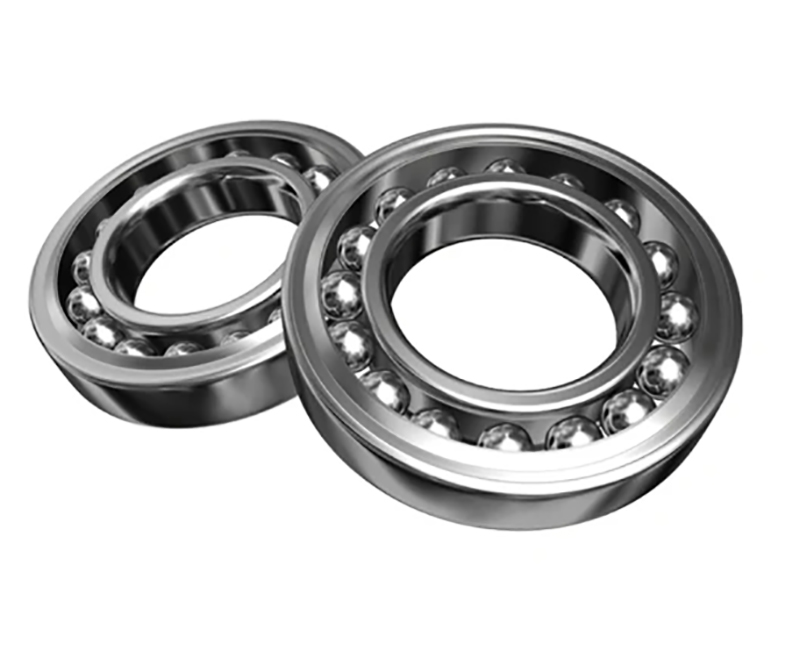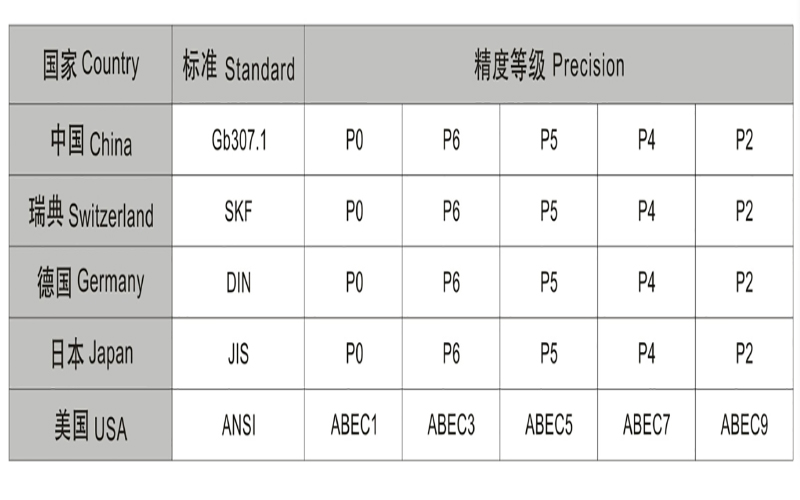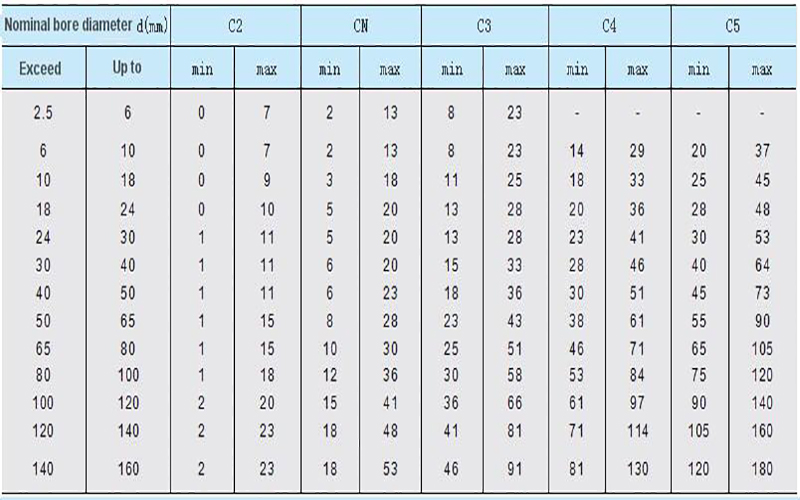Accuracy and Tolerance Classes of Deep Groove Ball Bearings: Comprehensive Guide and FAQ
Introduction
Definition of accuracy and tolerance in bearings
Bearing precision: bearing precision refers to the size of the processing error in the manufacturing of bearings and is an important indicator of bearing performance. It reflects the degree of accuracy of the bearing in terms of geometry, size, rotational accuracy and so on. According to ISO standards, bearing accuracy can be divided into grade system and tolerance system.
Bearing tolerance refers to the bearing manufacturing size and design size of the difference between the range, which allows the bearing size, shape and position within a certain range of change. The size of the tolerance directly affects the rotational accuracy, load-carrying capacity and service life of the bearing. Bearing tolerance is usually divided into two kinds: positive tolerance and negative tolerance; positive tolerance refers to the bearing manufacturing size being larger than the design size of the deviation, and negative tolerance refers to the manufacturing size being smaller than the design size of the deviation.

Importance in bearing performance
Deep groove ball bearing precision grade and tolerance grade are crucial to bearing performance; they will affect bearing running accuracy, load-carrying capacity service life and other performance indicators. It also affects the reliability and stability of the bearing in mechanical equipment.
Understanding Accuracy Classes
ISO accuracy classes (P0, P6, P5, P4, P2)
ISO accuracy classes (P0, P6, P5, P4, P2) are accuracy classification standards developed by the International Organization for Standardization (ISO) for bearings and other rotating machinery components. These grades reflect the degree of accuracy of bearings in terms of geometry, dimensions, rotational accuracy, etc., and are, in descending order, P0, P6, P5, P4, P2.

ABEC rating system
The ABEC rating system is a set of standards developed by the American Bearing Manufacturers Association (ABMA) under the Association/Committee for Annular Bearing Engineering (ABEC) for evaluating bearing tolerance classes. This system is primarily geared toward precision bearings, including deep groove ball bearings. It differentiates between different accuracy classes by means of numerical numbers (from 1 to 9), with higher numbers indicating higher accuracy of the bearing.
Comparison between ISO and ABEC systems
Both the ISO and ABEC systems are valid standards for evaluating the accuracy of bearings. Still, they differ in terms of the organization that developed them, the scope of their application, the classification of their grades, and the way they are numbered. Designated organization: The ISO system is formulated by the International Organization for Standardization, and the American Bearing Manufacturers Association formulates the ABEC system. I. Scope of application: ISO accuracy grades are widely used for a variety of rolling bearings. The ABEC system, although initially designed for skateboard shoe bearings, has gradually been applied to the evaluation of other precision bearings, especially in the U.S. market. Second, the grade division and numbering method: ISO system, ISO precision grade is usually expressed in P level, such as P0, P6, P5, P4, P2, etc. The smaller the number, the narrower the tolerance band and the higher the precision. Third, the ABEC system, ABEC rating system uses digital numbering to indicate the accuracy level; the larger the number, the narrower the tolerance band, and the higher the accuracy. The opposite of the ISO system of numbering. Fourth, the accuracy characteristics: ISO system, ISO accuracy grade from P0 to P2 gradually improve, each grade corresponds to a certain tolerance band range. ABEC system, ABEC rating system from ABEC-1 to ABEC-9 progressively improves the accuracy requirements.
The following is a cross-reference table of bearing tolerance classes from different national standards. This table is very useful for engineers and designers to select and use bearings in multinational projects.
International Standard Tolerance Grades for Bearings
|
ISO |
ANSI/ABMA |
DIN |
JIS |
|
0 |
ABEC 1 |
P0 |
0 |
|
6 |
ABEC 3 |
P6 |
6 |
|
5 |
ABEC 5 |
P5 |
5 |
|
4 |
ABEC 7 |
P4 |
4 |
|
2 |
ABEC 9 |
P2 |
2 |
Notes.
ISO: International Organisation for Standardisation
ANSI/ABMA: American National Standards Institute/American Bearing Manufacturers Association
DIN: German Industrial Standard
JIS: Japanese Industrial Standard
Generally speaking, the smaller the number, the higher the tolerance grade and the higher the precision.
This table compares four standards: ISO, ANSI/ABMA, DIN and JIS.
- ISO Grade 0 is equivalent to ANSI/ABMA’s ABEC 1, DIN’s P0, and JIS Grade 0. This is the most basic tolerance class.
- As the number decreases (or increases in the case of ABEC), the tolerance class becomes more precise. For example, ISO class 2 corresponds to ABEC 9, which is the highest accuracy class in the table.
- There are correspondences between standards, but they are different. This table provides a general comparison, but in practice, it may be necessary to refer to the specific standard documentation. 4.
- The ABEC (Annular et al. Committee) rating system is mainly used in the United States, while other countries use ISO or their national standards.
Tolerance Classes for Deep Groove Ball Bearings
Normal tolerance class
Normal tolerance grades for deep groove ball bearings include a number of grades such as P0, P6, P5, P4, etc. Some standards or brands may also include a P2 grade.

Special tolerance classes (C0, C2, C3, C4, C5)
The special tolerance classes (C0, C2, C3, C4, C5) of deep groove ball bearings are adapted to different application requirements by controlling the internal clearance (radial play) of the bearings. From C0 to C5, the internal clearance gradually increases, and the load-carrying capacity and application scenarios of the bearings change accordingly.
Factors Affecting Tolerance Selection
The main factors affecting the selection of tolerances are bearing load, rotational speed, accuracy requirements, mounting and dismounting methods, bearing type and size, the working environment and many other factors.
Measuring Parameters for Accuracy and Tolerance
Radial run-out
Radial runout is the maximum amount of variation in the diameter direction of the outer circle or coaxial bore of a component under test (e.g., bearing, gear, etc.) relative to a fixed reference point (e.g., axis) during 360 degrees of rotation or continuous rotation about a reference axis. This runout is usually caused by errors in the geometry of the part (e.g., out-of-roundness) or installation errors. It can be divided into radial circular runout and radial full runout.
Axial run-out
Axial runout is the up and down vibration in the direction of the spindle axis of a mechanical device due to various reasons when the spindle is rotating.
Inner and outer ring width variation
Inner and outer ring width change refers to the amount of change in the width dimensions of the bearing’s inner and the bearing’s outer rings. In the manufacturing and use of bearings, due to the influence of various factors (such as material deformation, processing errors, wear and tear, etc.), the width dimensions of the inner and outer rings may change.
Bore and outside diameter tolerances
Bore tolerance: Bore tolerance refers to the maximum and minimum size deviation range allowed for the bearing bore diameter, which indicates the accuracy level of the bore diameter.
Outer diameter tolerance: outer diameter tolerance refers to the bearing outer diameter of the maximum and minimum size deviation range allowed, expressed in the bearing outer ring diameter of the precision level.
Impact of Accuracy and Tolerance on Bearing Performance
Running accuracy
Running accuracy refers to the stability and accuracy of bearings in rotary motion; it is affected by the joint influence of precision and tolerance; high precision and small tolerance bearings can ensure higher running accuracy.
Noise and vibration levels
High-precision bearings usually have lower noise levels and are able to maintain lower vibration levels during operation. When the tolerance is too large, the precision of the fit between the rolling elements, inner and outer rings and other parts of the bearing is reduced, which can easily lead to uneven clearance and shock vibration, thus increasing the noise; too large or too small a tolerance may lead to unstable vibration of the bearing during operation.
Heat generation
High-precision bearings usually require smaller tolerance ranges to ensure the stability of their performance; too small tolerances may increase the difficulty and cost of manufacturing or lead to excessive assembly stress and accelerate bearing wear and damage. Therefore, when selecting precision and tolerance, they need to be considered to balance the performance, cost and service life of the bearing and other factors.
Bearing life
High-precision bearings and proper tolerance ranges can extend bearing life.
Selecting the Right Accuracy and Tolerance Class
Application requirements
Selecting the correct accuracy and tolerance grade requires a combination of factors, including functional requirements, manufacturing processes, assembly processes, economics, and standard specifications.
Operating conditions
Key operating conditions are a number of factors such as equipment conditions, material properties, process conditions, conditions of use and economics.
Cost considerations
When selecting the correct accuracy and tolerance grade, a number of factors, such as machining costs, raw material costs, scrap and rework rates, labour costs, and overall economics, need to be considered.
Manufacturing Processes and Quality Control
Precision manufacturing techniques
Precision manufacturing technology refers to the process of manufacturing parts and products with extremely high dimensional accuracy, surface finish, and form and positional tolerances through high-precision equipment, technology, and methods.
Quality assurance methods
Quality assurance methods include: establishing a sound quality control system, standardizing quality standards, conducting process capability verification, implementing process monitoring and testing, controlling nonconforming products, continuous improvement, and strengthening employee training and supplier management.
Testing and verification procedures
Testing procedures are a series of standardized processes for testing products, raw materials, components, etc., in the production process. Usually includes the following steps: develop a test plan, prepare test samples, execute the test, and record and analyze the test results. A validation program refers to the manufacturing process and quality control activities to confirm the effectiveness of a series of activities; validation procedures usually include process validation, equipment validation and document verification.
Future Trends in Bearing Accuracy and Tolerance
Advancements in manufacturing technology
The future trend of bearing precision and tolerance will be profoundly affected by the progress of manufacturing technology, which is manifested in the continuous improvement of precision level, further narrowing of the tolerance range, constant innovation of manufacturing technology and improvement of green environmental protection requirements. These trends will jointly promote the bearing industry to high-end, precision, intelligent and green direction.
Emerging high-precision applications
The future trend of bearing precision and tolerance will be influenced by various factors such as the growth of demand for high-precision applications, the promotion of technological innovation, the integration of intelligence and digitization, environmental protection and sustainable development, as well as market expansion.
Conclusion
Recap of key points
Understanding accuracy classes and tolerance grades; Measurement parameters for accuracy classes and tolerance grades; Impact of accuracy and tolerance on bearing performance; How to select the correct accuracy and tolerance grade; Future trends in bearing accuracy and tolerance.
Importance of proper accuracy and tolerance selection
Correct selection of deep groove ball bearing accuracy and tolerance can ensure bearing performance and improve the stability of mechanical equipment and operational efficiency.
Frequently Asked Questions
What is the difference between the accuracy class and the tolerance class in deep groove ball bearings?
Precision grade focuses on the overall manufacturing quality and performance of bearings, and tolerance grade focuses on the dimensional and shape accuracy requirements in the manufacturing process of bearings.
Accuracy grade is directly affected by the use of scene and mechanical design requirements, and tolerance grade is affected by the manufacturing process cost control and other factors.
Improvement of accuracy grade helps to improve the performance and service life of bearings, and improvement of tolerance grade helps to ensure that the dimensional and shape accuracy of bearings meets the design requirements.
How do I choose the right accuracy class for my deep groove ball-bearing application?
Selecting the correct accuracy class requires comprehensive consideration of a number of factors, mainly including clarifying the requirements for use and the working environment, understanding the meaning of the accuracy class, selecting the appropriate accuracy class according to the needs, considering the economic benefits, and referring to professional advice.
What are the main factors that determine the accuracy of a deep groove ball bearing?
The main factors are material quality, processing equipment and technology, heat treatment technology, assembly accuracy, testing and quality control, as well as the use of the environment and working conditions.
